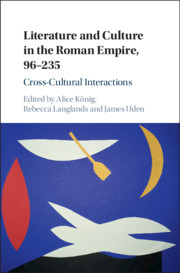Book contents
- Literature and Culture in the Roman Empire, 96–235
- Literature and Culture in the Roman Empire, 96–235
- Copyright page
- Contents
- Figures
- Contributors
- Preface
- Timeline
- Abbreviations
- Map
- Introduction
- Part I Refiguring Roman and Greek Interactions
- Part II Imperial Infrastructure: Documents and Monuments
- Part III Cultural Translation and Transformation
- Chapter 13 Bardaisan’s Disciples and Ethnographic Knowledge in the Roman Empire
- Chapter 14 Chaldean Interactions
- Chapter 15 Gilgamos in Rome
- Afterword
- References
- Index
Afterword
Not There: Empire, Intertextuality, and Absence
from Part III - Cultural Translation and Transformation
Published online by Cambridge University Press: 28 April 2020
- Literature and Culture in the Roman Empire, 96–235
- Literature and Culture in the Roman Empire, 96–235
- Copyright page
- Contents
- Figures
- Contributors
- Preface
- Timeline
- Abbreviations
- Map
- Introduction
- Part I Refiguring Roman and Greek Interactions
- Part II Imperial Infrastructure: Documents and Monuments
- Part III Cultural Translation and Transformation
- Chapter 13 Bardaisan’s Disciples and Ethnographic Knowledge in the Roman Empire
- Chapter 14 Chaldean Interactions
- Chapter 15 Gilgamos in Rome
- Afterword
- References
- Index
Summary
This Afterword brings Jewish evidence from the imperial period into the discussion of intertextuality in the Roman world as a way to underscore and at times challenge the themes animating the volume as a whole. Focusing on the problem of how to read silences and aporiae, it homes in on the observation made by Uden in the volume that many groups in the long second century shared in common a habit of defining themselves as sui generis, ‘projecting an artificial sense of isolation from others’. The early rabbis were masters of this sort of imagined recusal from the historical cultural landscape into their own internal categories genres and narratives, despite the reality of their participation in the Roman world. Pushing farther, the Afterword posits that rabbinic literature in some ways writes intertextuality large – by restricting itself to commentarial genres, the fiction of revelation, and refusal of authorship, the corpus strips itself of the apparatus of literary originality and ownership. In so doing it manifests explicitly what all literature implicitly is: intertextual, collaborative, connective. In its exaggerated posture of isolation, despite the fact of its embeddedness, rabbinic literature claims its place as part of the Roman bookshelf of the second century.
Keywords
- Type
- Chapter
- Information
- Literature and Culture in the Roman Empire, 96–235Cross-Cultural Interactions, pp. 344 - 354Publisher: Cambridge University PressPrint publication year: 2020

